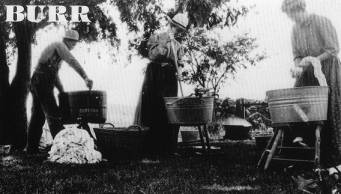 BURR -- OTOE COUNTY BURR -- OTOE COUNTY
Burr can identify its beginnings to those of other
"railroad-towns" that were established along the lines
being built out across the prairie. However, even
before Burr was
a town, it was a community with its own postal
address. A post
office was established on July 15, 1869, named "Burr
Oak," for the oak groves in the area. Later, it was
spelled
as one word -- "Burroak."
Surveyors charting a route for a railroad through
Otoe County
in 1886 crossed land settled by Levi Wilcox, George
Strong, Cyrus
Bassett, and Captain Ben Pindar. The route was
resurveyed, with
grading started in 1887. At that time, a town site was
platted on
the land owned by Winfield and Sarah Holden. One
writer suggests
that the town's name was chosen by Sarah Holden, whose
maiden
name was Burrell.
The first train to arrive brought mail and passengers
to the
depot in September 1888. According to Elton Perkey,
the railroad
had shortened the name to Burr, to avoid confusion
with Burr Oak,
Kansas. When the line was completed there were four
trains daily
-- down and back. There were also occasional
excursions to Omaha
-- with round trip tickets costing $1.
Barney Goerke built the first store. Other businesses
established in 1888 included the Holden House hotel, a
saloon, a
hardware store, a general merchandise store, a
lumberyard, and
two elevators. Various meeting places mentioned over
the years
include Wilcox Hall in 1889, followed by Landwehr
Hall, with
Panko Hall listed in 1911. In the late 1920s, Kenneth
Chase built
a large quonset-type building which was used to
present
"picture shows" and other gatherings.
The first school for district 101 was built in 1889,
with the
notation, "....Preaching and meetings were held in the
school until the churches were built." A large brick
building was constructed in 1935. The last high school
graduation, 12 students, was held in 1959. A K-8
school continues
to serve the community.
The earliest church, called the "Rockford Charge,"
was organized in the 1860s and built of rocks on Cyrus
Bassett's
homestead near the south branch of the Little Nemaha.
Rebuilt of
lumber on higher ground, the little white church was
moved to
Burr in 1891 using "home-made equipment." Beer kegs
were used to help float it over the creek west of
town. Currently
known as the Burr United Methodist Church, it
celebrated its
"centennial plus" in 1971.
 The Hopewell
Presbyterian Church, established in 1874, was
destroyed in the
1913 "Easter Tornado" that ravaged a wide area across
southeast Nebraska before striking Omaha where it
killed hundreds
of people. The church was rebuilt at that location,
which is in
the center of the Burr-Unadilla-Douglas-Syracuse area,
and next
to the Hopewell Cemetery. The Hope Lutheran church was
established in 1891, and in 1950 the old frame
structure was
replaced by a large brick one. The Hopewell
Presbyterian Church, established in 1874, was
destroyed in the
1913 "Easter Tornado" that ravaged a wide area across
southeast Nebraska before striking Omaha where it
killed hundreds
of people. The church was rebuilt at that location,
which is in
the center of the Burr-Unadilla-Douglas-Syracuse area,
and next
to the Hopewell Cemetery. The Hope Lutheran church was
established in 1891, and in 1950 the old frame
structure was
replaced by a large brick one.
The large percentage of settlers of German descent is
noted in
the names of early residents, and the American German
Bank, which
was organized in 1892 with capital of $9,500. Managed
by local
stockholders, the bank's name was changed on April 18,
1919, to
"The American Bank" due to the anti-German feeling
during World War I. A new brick building had been
completed
earlier that year.
Burr's peak population, 133, occurred in 1920. As
rail service
declined and was finally abandoned, the need for an
all-season
road to Burr was evident. After nearly 20 years of
work to get
the state to provide one, the highway board agreed to
build a
hard surfaced road "...if the population of Burr
reached 100
by 1970." That goal was achieved when the Don Parde
family
moved to town. This brought the total to 101, which is
also the
current population. The completion of the Burr Spur on
June 8,
1975, was celebrated with a ribbon cutting, a
barbecue, a ball
game, a street dance, and a fireworks display. Many
streets are
now paved, and all are graded and maintained.
A quick response team of 14 persons completed
training in the
1980s. "This is just another example of how our town
exemplifies people-helping-people, to make a better
place for
all," said Village Clerk Nancy Thormahlen when writing
Burr's history for the Otoe County History Book.
From material gleaned from records at the Nebraska
State
Historical Society, Perkey's Nebraska Place-Names ,
and the LNM
handbook.
|

